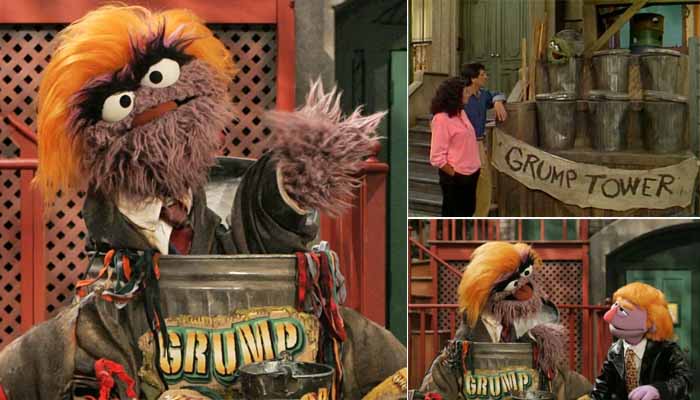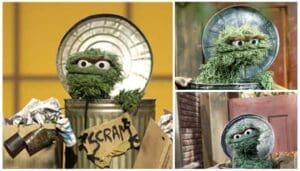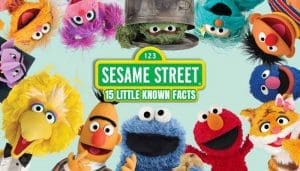Sesame Street. The name conjures images of sunny days, friendly monsters learning their ABCs, catchy songs about cooperation, and maybe a cookie or two (or ten). It’s a bastion of childhood innocence, teaching kindness, numbers, and letters for generations. But beneath the fuzzy surface and cheerful tunes, Sesame Street has always possessed a sharp, witty edge, often deploying clever pop culture parodies that sail over kids’ heads straight to the adults watching along. Parody, it turns out, is deeply embedded in the show’s creative DNA. And for nearly two decades, one particular public figure became a recurring target for this satirical lens: Donald Trump.
Enter Ronald Grump, a character whose appearances spanned from the late 1980s to the mid-2000s, evolving from a greedy Muppet developer to a human bully played by an Oscar-winning actor, and back again to a Muppet reality show host. This wasn’t just a fleeting gag; Sesame Street returned to the Grump well multiple times, adapting the parody as Trump’s own public persona shifted. The character even found a strange afterlife years later, resurfacing in online discussions during Trump’s presidency, adding an unexpected layer to his Muppet legacy. Let’s take a stroll down memory lane (or should we say, trash heap?) and explore the history of Sesame Street’s resident Grump.
1988: Grump Tower Rises (Made of Trash Cans)
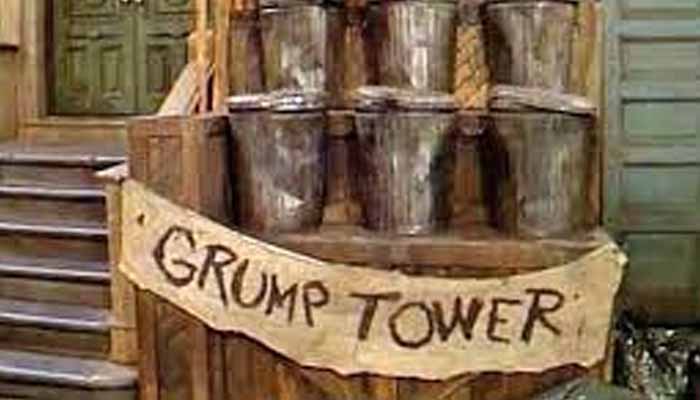
The saga began in 1988, in Episode 2399. Ronald Grump made his debut not as a human tycoon, but as a Grouch Muppet. This choice immediately placed him within the established logic of Sesame Street’s Grouch world, where residents famously adore trash and live in garbage cans. This first Grump was explicitly a “greedy Grouch land developer” , sporting loud clothing, including a particularly garish bowtie, and perhaps a tacky fedora. From the outset, the show’s writers left no doubt about Grump’s character; he was crafted as an unmistakable “bad guy,” sleazy and mean-sounding, a clear signal to the young audience about who not to emulate.
Grump’s scheme involved convincing Oscar the Grouch, Sesame Street’s original trash connoisseur, to let him build “Grump Tower” on Oscar’s property. This wasn’t just any tower; it was a “duplex can-dominium,” a high-rise constructed entirely from garbage cans. Oscar, initially, was thrilled, recognizing Grump’s reputation among Grouches: “You’re the Grouch who built the swamp in a day!”. Grump, playing on this, made sketchy promises of an incredible Grouch living situation, offering more room and Grouch neighbors.
However, the street’s human resident, Maria, immediately sensed trouble, recognizing the deal was too good to be true. Oscar, ignoring her warnings as usual, signed the contract. Once the tower was built, Grump revealed the catch: a strict “no pets allowed” clause. This meant Oscar’s beloved pet worm, Slimey, and his elephant, Fluffy, would have to go. Horrified, Oscar wanted out, but Grump pointed to the fine print: breaking the contract required a hefty payment of 40 bags of trash. This penalty underscored the value of trash within the Grouch economy; it wasn’t just refuse, it was currency, and Grump’s power stemmed from controlling this trash-based real estate.
Facing eviction or the loss of his pets, Oscar was distraught. But the Sesame Street community rallied around him. Seeing Oscar’s predicament, the residents pitched in, pooling their garbage to meet Grump’s demand. In a moment symbolizing community triumph over greed, Maria crumpled the exploitative contract and tossed it into the final bag needed to buy Oscar’s freedom. Ronald Grump was defeated, his trash tower effectively dismantled by collective action. Sesame Street was safe… for the time being.
1994: Joe Pesci Brings Grump to Life (and Tries to Demolish the Street)
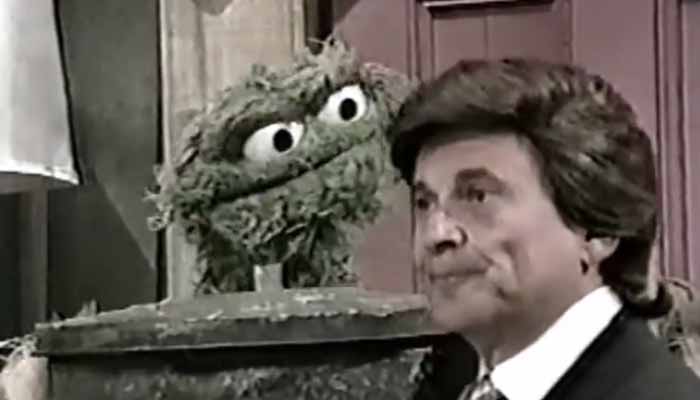
Six years later, Ronald Grump returned, but with a significant transformation. For the show’s 25th-anniversary television special, Sesame Street All-Star 25th Birthday: Stars and Street Forever! (1994), Grump was no longer a Muppet but a human, portrayed with characteristic volatile energy by actor Joe Pesci. Pesci, fresh off his GoodFellas fame, delivered a “yellingly delightful” performance , sporting appropriately high hair for the era, though perhaps not quite reaching the heights later associated with the man he was parodying. This shift to a human antagonist, played by a major star known for intense roles, made the parody feel more direct, arguably harsher, and raised the stakes considerably. The threat was no longer just a bad deal for Oscar; it was the potential annihilation of the entire neighborhood.
Pesci’s Grump arrived with ambitious, destructive plans: to level the beloved street and erect a massive luxury development, variously referred to as “Grump Tower” or even a theme park called “Grump World”. He bluntly gave the distraught residents a two-week eviction notice: “Pack up and get out!”. This Grump openly despised the very essence of Sesame Street, declaring, “If there’s one thing I despise, it’s cheap sentiment — hugs, kiddie television, cute, furry animals”. While most residents were understandably horrified, the cynical bellhop Benny Rabbit was briefly tempted by Grump’s promises of “the finer things”. The special featured numerous cameos, including John Goodman and Rosie O’Donnell (as a Glinda the Good parody), though O’Donnell sadly didn’t share screen time with Pesci’s Grump to recreate their real-life feud. Behind the scenes, Pesci apparently stayed in character, reportedly being “mean” to Elmo, even “thwacking” the beloved red monster.
Faced with losing their homes, the Sesame Street community exercised their right to protest, holding a rally to save their street. Grump attempted one last scheme, trying to bribe Oscar with a fancier trashcan elsewhere, but Oscar, representing the heart of the neighborhood, refused to move. The ultimate resolution, however, came not just from community spirit but from a surprising bureaucratic twist. Oscar revealed that his trash can was, in fact, “government property”. Faced with this immovable obstacle, Grump declared the neighborhood didn’t deserve his tower anyway and abandoned his plans. Though he claimed to “hate sentiment,” the special ended with Grump seemingly softened, reluctantly joining in the final, unifying performance of the classic song “Sing”. This time, the defense against the powerful, disruptive force came not just from collective action, but from an unexpected external rule that even Grump couldn’t bypass.
2005: Enter Donald Grump, The Trashiest Apprentice Host
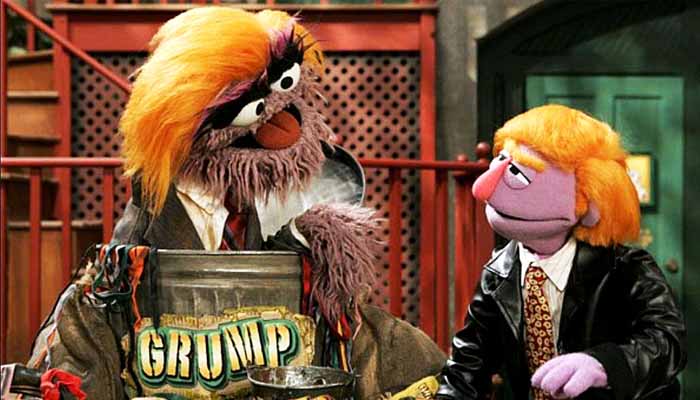
Fast forward another decade, and Grump reappeared in 2005 (Episode 4104, Season 36). This time, the character underwent another evolution, reflecting the shift in Donald Trump’s public image. He was now “Donald Grump” , returning to Muppet form but with a distinct new look: a bizarrely bright orange toupee/combover, bushy eyebrows, and a badly fitting suit. This iteration directly parodied Trump’s then-megahit reality TV show, The Apprentice. By this time, Trump was arguably more famous as the “You’re fired!” television personality than the 80s real estate developer, and Sesame Street’s satire adapted accordingly.
Donald Grump arrived on the scene with maximum Grouch bravado, heralded by other Grouches singing about his immense wealth – measured, of course, in trash. He popped out of his can screaming, “I’m Donald Grump and I have more trash than all of you so nyah nyah nyah nyah nyah!”. His reputation preceded him; his name was supposedly “on every piece of trash in town”. This emphasis on possessing vast quantities of branded trash as the ultimate status symbol perfectly translated Trump’s real-world focus on wealth and branding into the Grouch value system.
The episode’s plot centered around a “Grouchy Apprentice” competition. Grump announced he needed an apprentice to help sort his mountains of trash, promising the winner would get to keep some (but not too much) of his valuable garbage. Before the competition began, Grump summarily fired “Omagrossa,” a clear nod to Apprentice contestant Omarosa Manigault. Elmo, along with several Grouches, competed in Grump’s “trashy challenges,” such as guessing how many smelly fish fit in a bucket. The other Muppets largely ignored Grump’s flashy bragging, unimpressed by his claims of being the “trashiest”. Predictably, the ever-helpful and cheerful Elmo excelled at the tasks and won the competition.
This outcome enraged Donald Grump. “I’m a Grouch! I can’t have a good helper! I got my reputation to think of,” he declared. True to his reality TV persona, he abruptly rescinded the promised trash prize and dismissed Elmo with the iconic catchphrase: “Scram! You’re fired!”. Elmo felt utterly scammed, and the other Muppets branded Grump a liar. In some variations of the segment, the tables were turned when the other Grouches, refusing to help Grump under his unfair terms, fired him. Another account suggests the segment ended with Elmo yanking off Grump’s ridiculous orange wig. This final Grump appearance showcased Sesame Street’s ability to keep its satire current, targeting the specific cultural moment that defined its subject in 2005.
Deconstructing Grump: More Than Just a Bad Hair Day
Across his nearly two decades of sporadic appearances, Ronald/Donald Grump displayed a remarkably consistent set of negative traits, painting a clear picture for the show’s young audience. Greed was paramount, whether manifested in shady real estate deals aimed at acquiring Oscar’s prime trash can spot or hoarding mountains of personal garbage. Dishonesty was a hallmark, from the misleading contract offered to Oscar in 1988 to the blatant scamming of Elmo in 2005. Boastfulness dripped from him, particularly in his 2005 incarnation, bragging about having “more trash than anyone” with childish “nyah-nyah-nyahs”.
Furthermore, Grump often exhibited a thin skin and quick temper, exemplified by Joe Pesci’s tantrum when residents resisted his plans, and the Muppet Grump’s fury when the “nice” Elmo won his contest. His default mode of dismissal, the infamous “Scram! You’re fired!” , became central to his 2005 persona. Visually, the parody was reinforced through loud, tacky clothing in the first appearance and, most memorably, the distinctive orange hairpiece in the final Muppet version.
Crucially, Grump was never presented as merely eccentric or misunderstood; he was consistently framed as an antagonist. While his actions were sometimes filtered through the lens of Grouch culture (where valuing trash is normal), behaviors like lying, breaking promises, and treating others unfairly were clearly depicted as negative. This consistent negative portrayal wasn’t just for comedic effect; it served an educational purpose, highlighting undesirable traits in a way children could understand.
To clarify the different iterations, here’s a quick summary:
| Year | Character Name | Format | Key Plot/Parody | Notable Details/Sources |
|---|---|---|---|---|
| 1988 | Ronald Grump | Grouch Muppet | Builds “Grump Tower” (trash cans), tricks Oscar | Episode 2399; Focus on development; Resolved by community trash pooling |
| 1994 | Ronald Grump | Human (Joe Pesci) | Wants to demolish Sesame Street for “Grump Tower/World” | 25th Anniversary Special; Resolved by Oscar’s can being government property |
| 2005 | Donald Grump | Grouch Muppet | Hosts “Grouch Apprentice,” seeks helper, fires Elmo | Episode 4104; Parody of The Apprentice; Distinct orange wig; “More trash than anyone” |
Why Target Trump? A New York Fixture Meets Sesame Street Values
Why did Sesame Street zero in on Donald Trump for such sustained parody over the years? Part of the answer lies in his status, particularly in the 1980s, as a quintessential, almost unavoidable New York City figure. He was a fixture in the city’s tabloids, synonymous with flashy real estate development and a certain kind of ostentatious wealth. For Sesame Street’s writers, many of whom were described as “dyed-in-the-wool New Yawkers,” drawing inspiration from local headlines and personalities was natural. Trump, in the 80s, was even considered a stereotype of a rich person. This initial local relevance made him a readily available archetype for the NYC-based production. As his fame grew nationally and globally, first through reality TV and later politics, the earlier parodies gained new layers of meaning, transforming the character from a local caricature into a symbol recognized far beyond New York.
Beyond the local connection, the Grump character served Sesame Street’s core educational mission. The show has always aimed to teach children not just letters and numbers, but also social-emotional skills and values. Grump provided a clear, recurring example of undesirable traits: greed, dishonesty, boastfulness, and a lack of empathy or fairness. By presenting these behaviors through Grump and contrasting them with the positive actions of characters like Maria or Elmo, the show offered subtle ethical instruction. The parody wasn’t merely poking fun; it was illustrating behaviors that conflicted with the show’s pro-social values.
It’s important to place the Grump parodies within the show’s long and rich tradition of spoofing popular culture. Sesame Street has lampooned countless celebrities, TV shows, movies, and cultural phenomena over its history, from “Monsterpiece Theater” (hosted by Alistair Cookie, a parody of Alistair Cooke) to spoofs of Game of Thrones, Law & Order, Survivor, and blockbuster movies. Numerous celebrities have appeared as themselves or been parodied. The Sesame Workshop itself situated the Grump character within this broad context of parodying public figures and pop culture icons. What perhaps makes Grump stand out is the duration of the parody across different eras and the consistent negativity of the portrayal. Interestingly, when asked in a 2015 interview whom Donald Trump might interact with on Sesame Street, Emilio Delgado (who played Luis) suggested a “tete-a-tete with Oscar the Grouch,” adding that while Oscar is very grouchy, Trump might even beat him. This comparison highlights the “grouchiness” often attributed to the real Trump’s persona, even beyond the specific Muppet parody.
Grump’s Unexpected Afterlife: From Muppet Villain to Political Talking Point
For years, Ronald and Donald Grump remained relatively obscure figures in the vast Sesame Street universe. However, the character experienced a surprising resurgence in public awareness during Donald Trump’s political career, particularly when his administration proposed significant budget cuts to the Corporation for Public Broadcasting (CPB), which supports PBS and NPR. Suddenly, the decades-old clips of Grump took on a new, almost eerie relevance. The irony was potent: the character inspired by Trump had, in the 1994 special, literally tried to destroy Sesame Street, mirroring the perceived threat posed by the real Trump’s proposed funding cuts to its long-time broadcast home.
While Sesame Street had moved its first-run episodes to HBO by that time, PBS remained vital for ensuring the show’s accessibility to all children, particularly those from less privileged backgrounds who relied on free public television. The proposed cuts ignited public outcry, and fans quickly unearthed and shared the Grump segments across the internet and social media as a form of pointed commentary. This phenomenon highlighted how digital platforms can breathe new life into archival media, allowing old content to be re-contextualized and amplified within current events in ways unimaginable when the segments first aired. The Grump story became widely known precisely because the video evidence was so readily shareable online.
The Sesame Workshop maintained that the Grump parodies were simply part of their long history of satirizing pop culture figures and that they had no plans to revive the character. However, for many viewers, the clips transcended simple parody, resonating as a strangely prescient critique. The real-world political events inadvertently gave the fictional plots of 1988, 1994, and 2005 a sharp, contemporary edge, demonstrating a peculiar instance of life imitating art – or, perhaps more accurately, life imitating satire.
Conclusion: The Grouch Who Mirrored a Mogul
The story of Ronald and Donald Grump is a fascinating thread in the rich tapestry of Sesame Street history. From his origins as a greedy Grouch developer in the late 80s, to his human manifestation played by Joe Pesci in the 90s, and his final Muppet form as a trash-obsessed reality TV host in the mid-2000s, the character consistently mirrored aspects of Donald Trump’s evolving public persona. Throughout these transformations, the portrayal remained unflinchingly negative, using the parody not just for laughs but as a vehicle for illustrating undesirable character traits like greed, dishonesty, and boastfulness.
Grump’s journey exemplifies Sesame Street’s unique capacity to blend education, entertainment, and surprisingly pointed satire. The show leveraged a recognizable, larger-than-life figure from the adult world to teach subtle lessons about fairness, community, and integrity, all while staying true to its own Muppet logic (where trash can be treasure). Though perhaps intended as a topical caricature, Ronald/Donald Grump gained an unexpected and enduring resonance, becoming a quirky footnote in television history that serves as a reminder: even on the sunniest of streets, sometimes the most notable resident is the Grouch who boasts of having more trash than anyone else.

